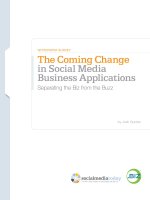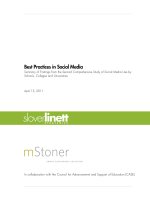Primer in social media
Bạn đang xem bản rút gọn của tài liệu. Xem và tải ngay bản đầy đủ của tài liệu tại đây (138.47 KB, 8 trang )
Examining the phenomenon, its relevance, promise and risks
A smashLAB White Paper by Eric Karjaluoto
March 1, 2008
A Primer in
Social Media
2 smashLAB White Paper: A Primer in Social Media
An introduction
to social media
Background
In the past, broadcasting was limited to
those with the financial resources to access
mass media. The emergence of low-cost
and highly accessible communication tools,
however, has changed all of this. Now,
anyone with an internet connection has
the ability to share their message with a
worldwide audience.
What is social media?
The term “social media” represents media
that users can easily participate in and
contribute to. Forms of social media include
blogs, forums, virtual worlds, wikis and
social networks.
What characterizes social media?
Although definitions vary, a few key
characteristics are common amongst social
media platforms. Most of these properties
thrive on the notion of participation and
making connections. Part of this is informed
by the notion of a flat community, in
which all parties engage in open dialogue.
Influence and credibility are prized in this
arena, as the user’s reputation can often be
a key motivator for one to remain active in
the dialogue.
How it’s different
Perhaps the biggest difference between
traditional media (newspapers, television,
radio, books, etc.) and social media is the
dynamic and flexible nature of the latter.
Social media can change with time and
be edited by the author and, in some cases,
the community. Likewise, the audience can
interact with and republish social media. It
lends itself to being archived, indexed by
search engines, and shared by users in
many ways.
Why it’s important
Although there are many reasons why social
media is notable (which we will address later
in this document), there is one reason that
stands above the rest: the people. Social
media brings with it the power of every user
on the planet. Its growth and future potential
is enormous.
..................................................................
Consider that there are:
(at the date of this paper’s preparation)
• 112.8 million blogs tracked on Technorati
1
• 66 million users on Facebook
2
• 72.6 million videos posted on YouTube
3
..................................................................
What it means for companies
Traditional marketers are accustomed to
carefully honing messages. This allows
for control, but the results are difficult and
costly to measure. Social media turns this
whole scenario around. With it, control is
shared with the crowd, and real feedback
becomes immediate.
Organizations now have the opportunity
to collect detailed information on users
and their habits, elicit real feedback and
suggestions, and refine their offering and
Executive Summary: Social media represents a broad change
in how people communicate with one another. This is exciting
for businesses as it presents new channels and methods of
reaching consumers. As such, early adopters have encountered
both successes and failures in developing strategies that
incorporate this new paradigm. smashLAB advises groups to
remain strategic and pragmatic in employing social media.
3smashLAB White Paper: A Primer in Social Media
messaging to better suit user demands.
Although there are trade-offs with this new
way of communicating, the opportunities
for companies to understand and work with
their customers have never been as great.
Social media
in action
REAPING THE REWARDS
A few organizations have experienced
success in employing social media. Some
companies have even been fortunate
enough to have their brands championed
without their involvement.
Fountains of publicity
In September 2005, Steve Spangler made a
television appearance in which he dropped
a Mentos candy into Diet Coke, resulting
in a “cola geyser”. A video of this was
later posted on YouTube, inspiring more
than 12,000 similar experiments, most
famously “The Extreme Diet Coke & Mentos
Experiment”.
5
Pete Healy, Mentos U.S. VP
of Marketing, estimated the value of the
buzz generated by the effort to be “over
$10 million.”
6
A little less evil
After joining Microsoft in 2003, Robert
Scoble started blogging about the
company. While promoting certain products,
he also publicly criticized his employer and
even applauded their competitors. He was
incredibly open with his audience, even
encouraging them to call him in person
with problems they were experiencing.
7
As
a result, he shifted public opinion about
the organization. “[He] has also succeeded
where small armies of more conventional
public-relations types have been failing
abjectly for years: he has made Microsoft
... marginally but noticeably less evil to the
outside world...”
8
March of the Penguins
Washington, D.C.-based moms Gretchen
Volgenzang and Paige Heninger run
Fritz Grobe and Stephen Voltz’s “Extreme Diet Coke
& Mentos Experiments” have been viewed online by
approximately 20 million people.
Source: www.eepybird.com
Figure 1: Social media’s influence on IT purchasers
ITtoolbox Surveyed 400,000 of its members, to learn what aspects of social media IT decision
makers and influencers found most valuable in relationship to purchasing.
53%
Provides access to
objective feedback on
products and services
from multiple sources
Source: ITtoolbox/PJA IT Social Media Index: Inaugural Survey Results: June 7, 2007
12%
Offers more accurate information
on news and trends
11%
Provides information to
stay ahead of competition
24%
Offers the ability to participate
in conversations with peers
4 smashLAB White Paper: A Primer in Social Media
a podcast from their home called
MommyCast. After enjoying the film March
of the Penguins, they spoke favorably
about it on their podcast. The ensuing
publicity was enormous. The film went on
to generate $100 million in revenue, and
Warner Bros. attributes 25% of the film’s
revenue to this single podcast.
9
SOCIAL MEDIA BLUNDERS
Meanwhile, other companies have
(sometimes undeservedly) experienced
just how rapidly social media can expose
weaknesses. Some early adopters have
also had social media campaigns backfire.
Krypto-nightmare
Perhaps one of the blogosphere’s earliest
cautionary-tales was in 2004, when
Kryptonite Locks found itself in the midst
of a public relations nightmare. Videos
10
circulating on the internet showed how
certain locks could easily be compromised
with a simple ballpoint pen. Although
Kryptonite’s Public Relations Manager
refutes this point,
11
many criticized the
company for not responding quickly enough
to the situation. Regardless, the damage to
the Kryptonite brand was done.
Community-generated dissent
Embracing community-generated content,
GM teamed with The Apprentice, and
invited users to create their own ad for the
2007 Chevrolet Tahoe. The campaign did
in fact become viral, but perhaps not in the
way intended. A number of users created
videos that criticized the SUV and its impact
on the environment. As a result, phrases
such as, “because you hate mother
nature”
12
became the ad-copy for the
Tahoe. Although GM representatives
accepted that they would, “get some bad
with the good”,
13
it’s hard to imagine them
repeating the campaign.
Asleep on the job
Comcast subscriber Brian Finkelstein
uploaded a video entitled “A Comcast
Technician Sleeping on My Couch”
14
to
YouTube. In his brief video, he overlays
criticism of the company atop video footage
of a Comcast technician asleep on the
couch, while on hold with the company’s
central office.
15
At the date of this article,
over one million had watched the video.
WHAT COMPANIES ARE DOING
WITH SOCIAL MEDIA
While the above examples primarily
reference efforts independent of the
organizations, it must be noted that some
early adopters have had success with their
own social media efforts.
Common forms of social media
Blogs (short for web logs) are websites that typically feature posts, by an individual or group, which
readers can comment upon. Blogs vary widely in nature, but tend to be popular as they often provide
an unvarnished, insider perspective on a particular topic.
Forums are areas in which multiple users can create topics and then comment on these topics.
They are commonly used as resources for those interested in a particular topic. For example, guitar
players might all take part in a forum on this topic in order to share knowledge.
Content communities are sites that allow users to post and share content. Such communities exist
around anything from videos and photos to stories and links. Some of these sites include voting
functions that allow the community to determine the relevance of content.
Virtual worlds represent one of the most novel areas on the web, in which users can engage in
immersive worlds. Some of these spaces closely mirror real-world notions such as community and
economics.
Wikis are community-generated documents and databases. Approved users can create content and
augment that of others in the interests of creating better resources. Wikipedia is arguably the best
known wiki, with over 2 million
4
articles in the English edition alone.
Social networks are virtual communities that allow users to connect with others. Some of these
venues appeal to broad groups (i.e. Facebook) whereas others are built around particular niches and
demographics (i.e. LinkedIn).
Although many other forms of social media exist (including news aggregators, microblogging,
podcasts, and mash-ups) the examples presented focus mainly on the forms listed above.
5smashLAB White Paper: A Primer in Social Media
Target connects with freshmen
During the summer of 2007, Target
employed a social media campaign in
which their Facebook page was themed as
a “Dorm Survival Guide.” In it they offered
aid to anxious college newcomers through
design advice, recipes, and the like. By
the end of the campaign, the effort had
attracted over 7,000 members and has
been lauded as a success. This is partly
due to Target building a dialogue with
visitors instead of trying to immediately sell
their wares.
16
Dell gets out of Hell
After much criticism for poor customer
service, the direct-sell computer company
earned the rather unfortunate moniker
“Dell Hell.” (Googling the term results
in a long list of links largely tied to
customer dissatisfaction.) In response to
this, Dell executives worked to improve
customer relations and actively join in the
conversation.
17
Dell has even developed the property
IdeaStorm—a community driven forum
in which customers are invited to note
problems, share suggestions with the
company, and even assist fellow
customers.
18
Since then, some past
critics have praised the company for their
improvements and negative blog posts
about the company have purportedly
dropped from 49% to 22%.
19
A community with substantial ROI
Proctor & Gamble seems to have hit a
home-run in the social media space with the
creation of their beinggirl community. It may
be surprising to some that the site does so
well, given the overt product references and
slurry of marketing messages; nevertheless,
the content seems to resonate with the
site’s audience.
The site has been informed by both
health care experts and teenagers in
order to maintain accurate information in a
language that resonates in this community.
The site sees over 500,000 monthly visitors,
and its “Ask Iris” advice section receives
more than 3,000 questions each week.
20
P&G’s internal assessment purports that
every dollar they spend in this community is
four times as effective as the same dollars
spent on television.
21
Opportunities in
social media
Social media brings with it a great number
of opportunities; in the interests of brevity,
however, let’s concentrate on a few key
considerations for businesses. Each
organization’s experience will be unique
and it stands to reason that many will find
alternate gains in this arena.
Connect with passionate users
High-quality fishing line; methods for
steam-lining packaging; precision drumming
hardware; regardless of the topic, there’s
likely an audience for it somewhere, and
never before has the opportunity to reach
interested parties been so present.
Applying the principle of The Long Tail
22
,
companies can now employ social media
strategies to reach audiences who are
receptive to their messages.
As advertisers, we no longer need to
interrupt everyone with a message; instead,
we can engage interested parties through
social media, and give them good reason
to be our advocates. Apple is perhaps the
best example of a company whose users
take a personal interest in promoting the
brand they love. There are even a few
long-running sites dedicated to sharing
rumors and theories about potential product
releases from the company.
Build relationships
While the notion of the “relationship” is
looked upon with reverence by many, the
old methods of building them were time-
intensive and hardly effective. Being called
upon by a sales person rarely seemed
like anything more than an intrusion.
Social media, however, provides potential
customers the opportunity to interface with
your company on their own accord.
Even by simply presenting insider
expertise, companies are finding that they
can generate increased traffic for their
websites and interest in their products and
services. Some are even exploring ARGs
23
and Branded Entertainment
24
that help
imbue their brand values. Although these
venues may not immediately lead to sales,
the awareness generated often results in
valuable long-term returns.
The economy and reach of social media
tools make it possible to improve the
experience that users have with companies.
In fact, a 2002 study by AT&T found that
community users remain customers 50%
longer than non-users.
25
Using web-based
support and forums in addition to call-
centers affords users full-time access to
your assistance, while building a repository
of knowledge and user-based insight that
remains in the webosphere indefinitely.
Intuit’s community features over 100,000
people who help one another with their
problems while providing the company with
insight into customer needs.
26
The Chevy Apprentice user-generated ads often
reflected a sentiment that perhaps wasn’t what the
company had anticipated.
Source: www.youtube.com









